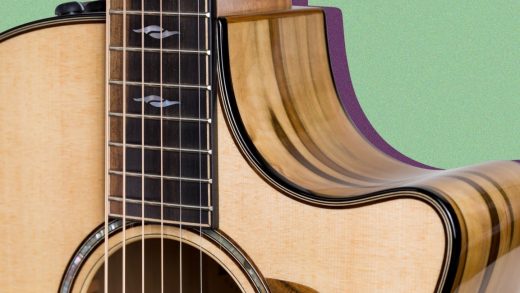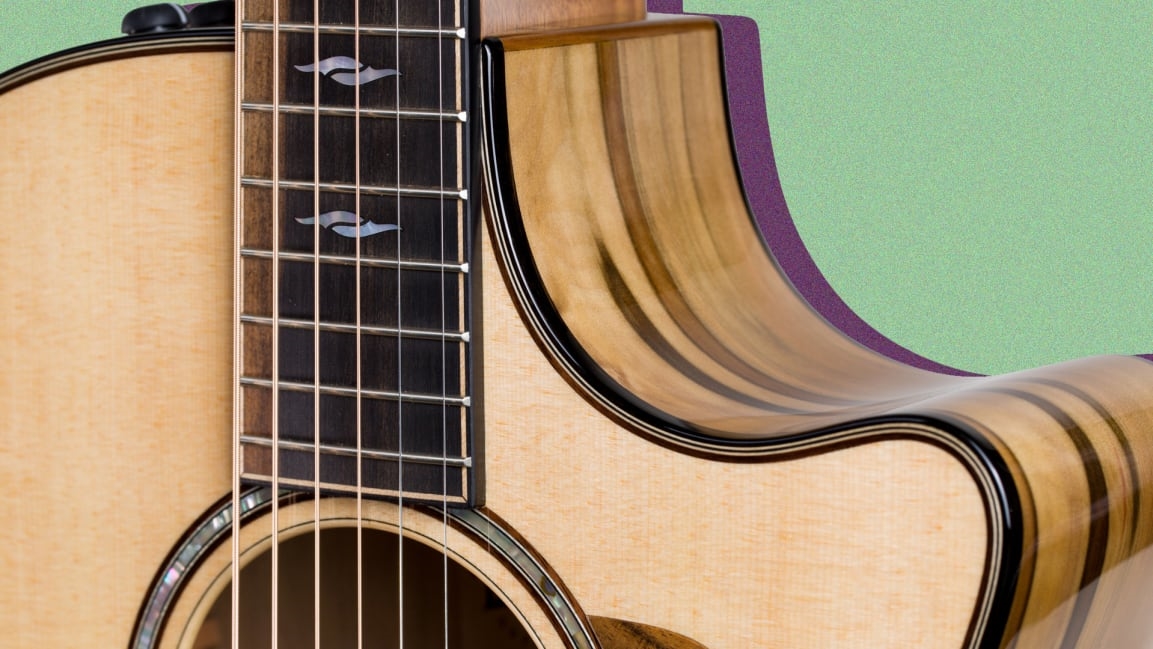This homeschooled music wunderkind now leads a top guitar company
Founded in 1974 by Bob Taylor and Kurt Listug, Taylor Guitars has grown from a small San Diego guitar shop into the No. 1 manufacturer of acoustic guitars in America, selling over 160,000 guitars annually. Propelling that growth is the founders’ passion for innovation and playability—qualities that distinguish the brand from its competitors. Seeking to pass their brand forward to a successor who shares their unwavering commitment to building better instruments with better materials, the founders tapped master guitar designer Andy Powers, just 29 at the time, in 2011. We sat down with Powers to talk about his vision for Taylor Guitars and the company’s enduring commitment to crafting instruments that guitarists will love playing.
What led you to making music and designing guitars at Taylor Guitars?
I made my first guitar when I was seven. I worked on it for weeks and weeks. In the end, I had built this thing, but it wasn’t really a guitar.
It was a guitar-shaped object. I watched it explode into pieces when I tried to tighten the strings up. I thought, okay, well, that’s a bummer. Then I ran and looked inside my parents’ guitar and I realized—ah, there are sticks inside! Mine probably wasn’t strong enough. So I tried again.
By the time I was 13 years old, I was doing repairs for a lot of the local music shops and building and selling ukuleles and guitars. I learned that everybody’s got a broken guitar to fix.
Bob actually offered me a job at Taylor Guitars when I was about 15.? I was sitting next to him at a concert, and by that point I knew who he was. I’d brought a ukulele that I’d made and showed it to him. Bob said, “Hey, man, this is really cool. If you ever need a job, look me up.”
I was homeschooled, and my parents really supported and encouraged me in my education. After high school, I went to MiraCosta College and UC San Diego to study music, where I spent most of my time building and selling guitars to my professors and classmates. I was doing really high-end custom guitars for people and continued to play because I liked that side as well.
Looking back, I owe it to my parents for getting me into making music and making instruments. I can’t really separate the two crafts—one is just an extension of the other—and both have been part of my family, a part of me, for my whole life. I love that I can not only make my own music but also touch other people’s music by crafting instruments for them.
Did Bob and Kurt explain what they were looking for in a successor when they began talking with you about taking over?
Bob actually wrote what he calls? a “Dear God” letter, though I didn’t know that it existed until later. He literally took out a piece of paper and wrote down the things he wanted in his successor: A guitar maker who’s a better builder than he is himself.? A pro player. Someone who is self-taught, has 20 years of experience, and is in their thirties.
Bob said that he laughed at it because it was an impossible list. He put it in his desk drawer. He never thought he’d find me. What he was looking for was a younger version of himself, someone who wasn’t out for quick money but wanted to make Taylor Guitars even better.
When you’re creating something, how do you know when to keep going for incremental improvements and when to branch out and try something entirely new?
Well, a trend or a theme that you’ll see throughout every one of the stories that Bob and Kurt tell is that they will develop an idea and work toward it until they reach a point where they can’t pursue it any further. It’s that point where you realize, “If I want to keep moving forward, I either have ?to step sideways or start moving in a totally different direction.” For Bob, this happened with the way a guitar neck is conventionally attached to its body. He innovated on the neck as far as he could go, then he said, “Well, if I want to keep going, I better get on a different horse, because this one’s not going any farther.”
Here’s another example. In 2012 and 2013, we totally redesigned our flagship line of guitars, the 800 Series. It’s a modern icon of the acoustic guitar world, but we threw away a ton of the design and refined it to within an inch of its life, tweaking little parts here, taking off a thousandth of an inch there. We adopted a lot of the techniques you might see in a real high-end, solo guitar maker’s shop—such as specialty glues and finishes. We obsessed over all kinds of details to get the last half of a percent out of the thing.
When we unveiled them, you know what? Musicians talked about falling in love with their guitars all over again. They became a huge commercial success. And the reason is simple: They’re just really good guitars!
Before long, here I am, back in the workshop, thinking, “This is terrifying!” After all, I just threw everything that I possibly could at this guitar, stretching the factory to the brink. Now what? Well, I’m not dead yet, so I’m not done yet. So how do I make this an even better guitar? In those moments where I don’t really know, I break things into smaller, more objective, obtainable goals.
What do you imagine Taylor Guitars will look like in 10 years? What will still exist and what will change?
I’d like to think that the culture won’t change, because we have intention and purpose. But the specifics of each guitar we make will change because we won’t be living in the same world 10 years from now. Maybe we’ll have different models. Maybe we’ll use different materials. I can also see playing styles changing.
Consider technology. Technology is changing so rapidly that the instrument world doesn’t really know how to keep up. I’m curious to see what we’ll come up with. People are increasingly using a lot more artificial or synthesized sounds, so one of my intentions is to find out how a fairly traditional, organic instrument can better fit within a modern, high-tech environment. That means the notes will have to be far more accurate and the instrument will have to be more microphone-friendly. In other words, it will have to play well with others.
I’m working on some instruments today that—while they don’t yet exist—I believe they should. Mostly because I think musicians would like making music with them. They may not be guitars as we’ve known them in the past, but they certainly could be guitars as we would someday know them.
The musicians I watch, they’re combining a wider variety of influences than they’ve ever had. Music is constantly changing. It doesn’t seem to remember the era it was tied to very well. Musicians pick and choose music and put it together. Then new musicians do it differently.
Look at the Steinway Model D grand piano. You could imagine Vladimir Horowitz, Dr. John, and McCoy Tyner all playing the same one piano, but none of them would sound anything alike. That speaks to the greatness of a design like that.
In the guitar world, we haven’t attained that kind of greatness yet. There is no one universal guitar for every music and every musician. But that’s what I’m working towards: a guitar that works for everyone, no matter their influences.
What advice could you give to a leader charged with taking over a company from its founder and building it for the future?
I would look at what they’re hoping to achieve—their intention. In my case, I’m here to serve the musician and the instrument. I don’t need my name to be on display. I’m not looking to be rich or famous. I want to add something to that great pool of what I’ve come to love—to contribute something to the world of music and guitars.
Part of my job is to make sure there’s a Taylor Guitars here to help the next generation execute all their wonderful new ideas. One part of that is making sure that the business side doesn’t take over the whole thing. That’s what Bob did for us—me, our workers, our suppliers, and the people who play our guitars. He taught us to protect the personal ambition that drives the brand. I’d give the same advice to anyone else.
And I’d say to do what Bob and Kurt did: Find others who can help carry your ambition forward. They could have bequeathed the company to a relative, but instead it’s almost like they gave it to the world of musicians. I didn’t have to be a founder’s son or daughter to take over the job of running Taylor Guitars. I’m here because I had a purpose larger than my own self-interest. Someday, I’ll hand the brand over to the next generation. I’ll disappear, and someone else will take over where I’ve left off. Hopefully, they’ll do a better job than I could ever do—and, generation after generation, our brand will sustain.
Mark Miller is the chief strategy officer at Team One, a fully integrated media, digital, and communications agency, and the coauthor of Legacy in the Making (McGraw-Hill Education). He is a regular contributor to Fast Company.
(28)



